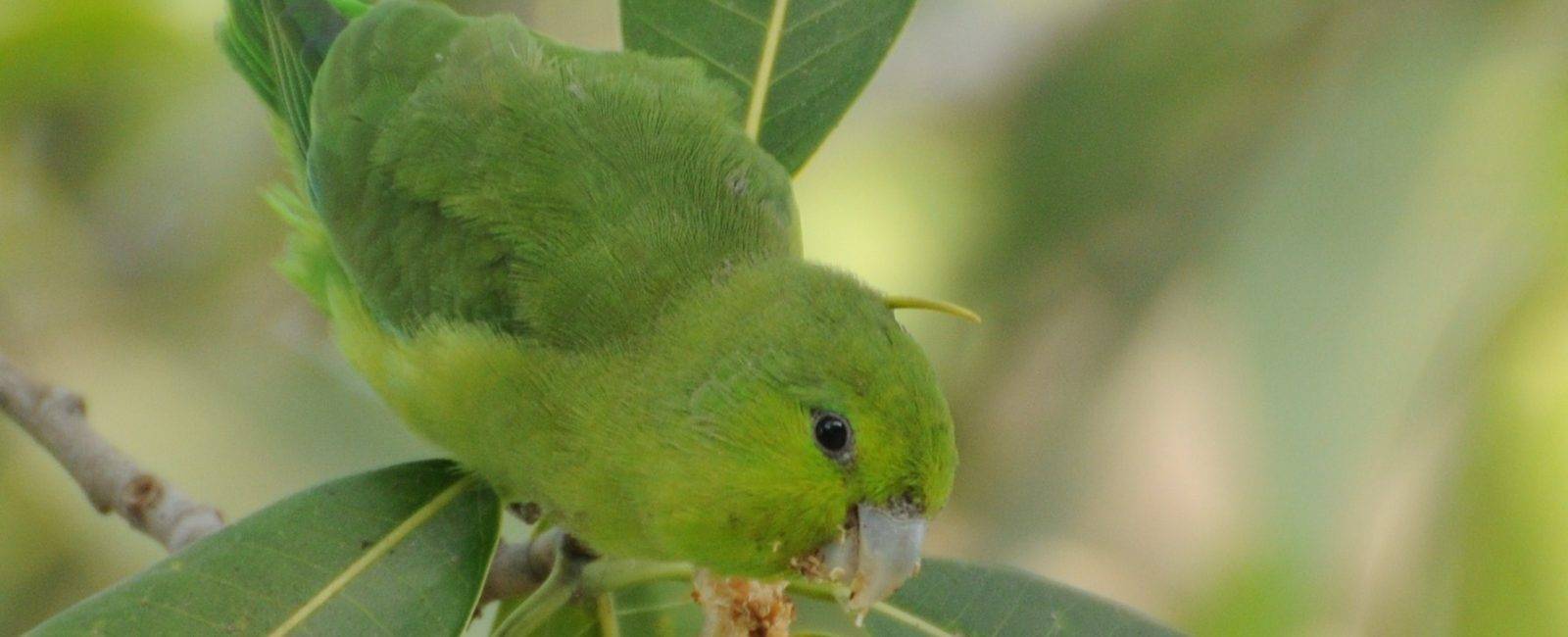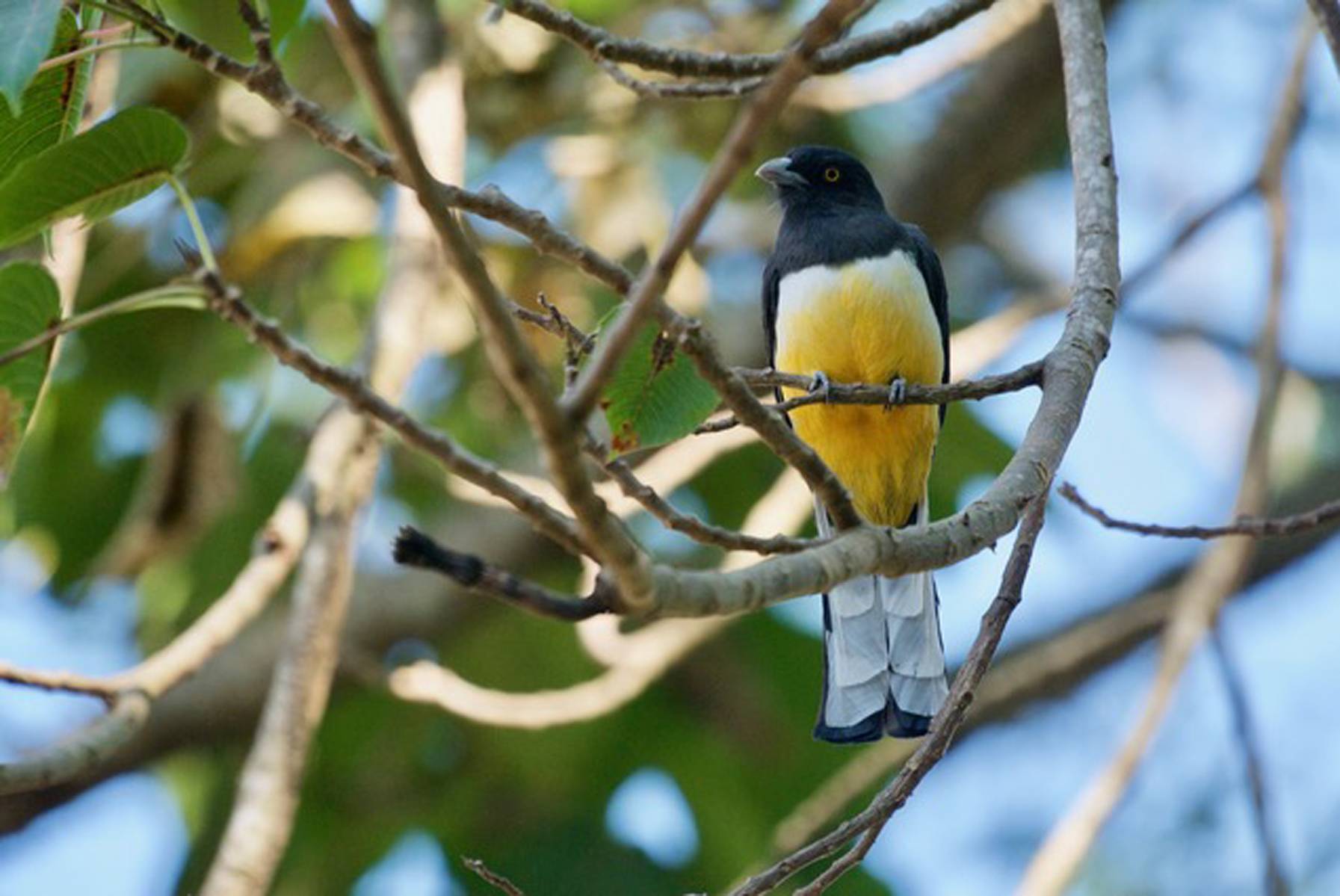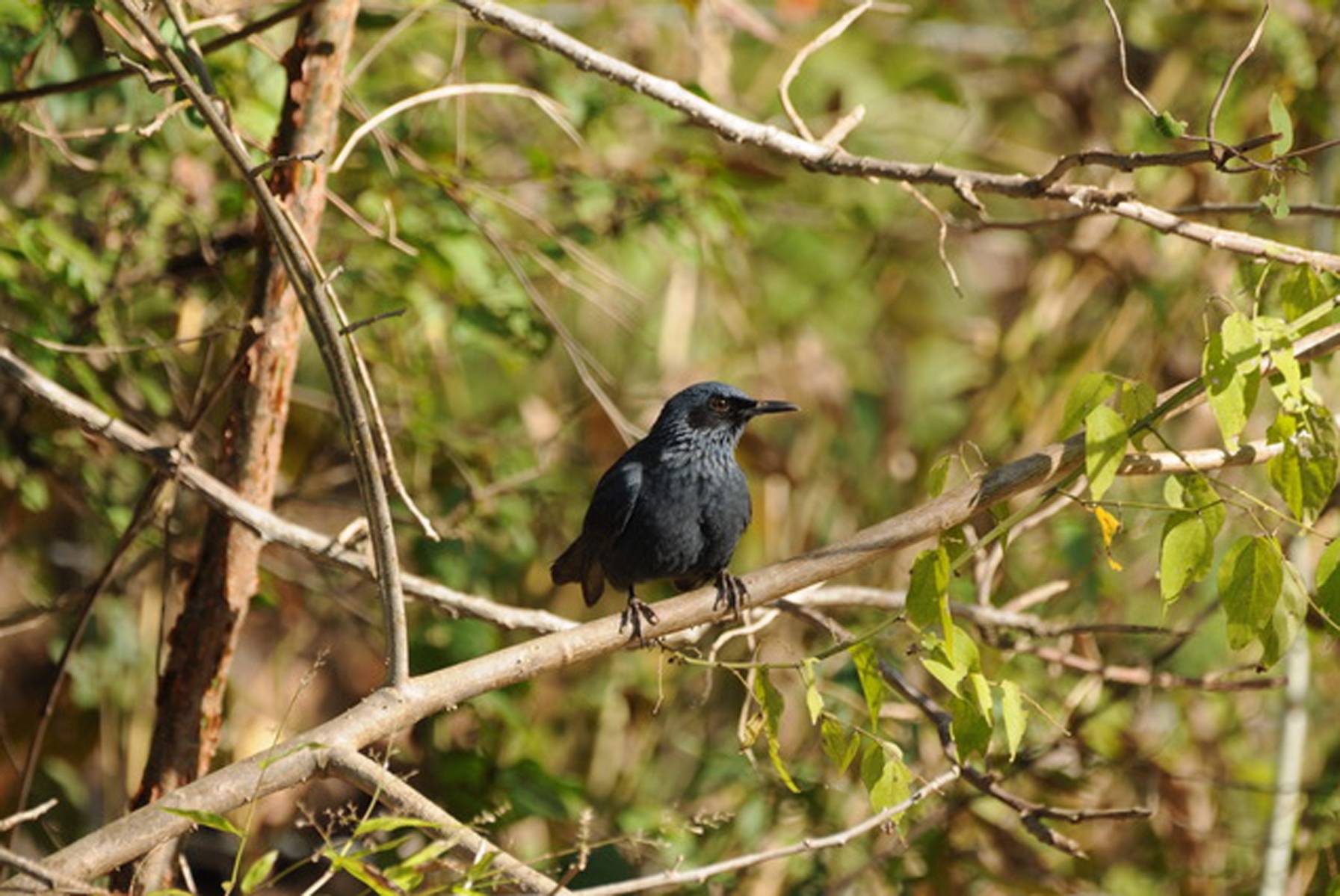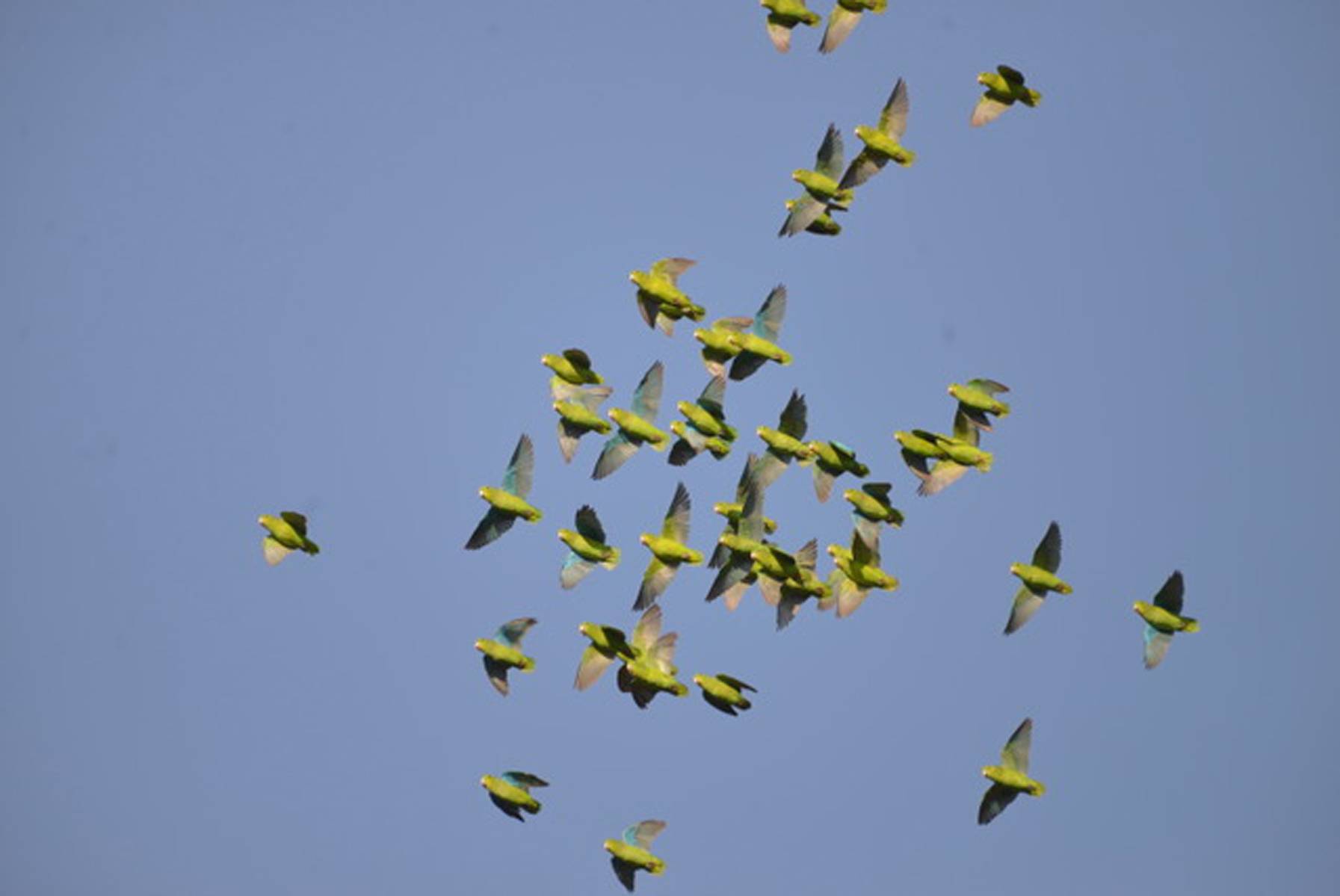Birding Tours in Puerto Vallarta and Riviera Nayarit
By Gerardo Hernández Vázquez
Bilingual (English-Spanish) Guide, Specialized in Nature-oriented Tourism.
Puerto Vallarta is located in the state of Jalisco, on México´s Pacific coast Bahía de Banderas (Banderas Bay). The bay is surrounded by the Sierra Madre Mountains, and it is probably the only place where you can find some of the endemic birds of both México´s Northwest and Southwest.
On our private guided birding tours with you and your group, we will explore rivers, riparian vegetation, mangroves, beaches, palm and thorn forest, tropical sub-deciduous forest, tropical dry forest, holm oak forest, pine-oak forest and cloud forest. These habitats are home to birds ranging from Blue-Footed Booby (Sula n.Nebouxii) to the Russet-Crowned Motmot (Momotus mexicanus). Other highlights among the many possibilities, including Mexican endemics, are: Rufous-bellied Chachalaca (Ortalis wagleri), West Mexican Chachalaca (Ortalis poliocephala), Elegant Quail (Callipepla douglasii), Lilac-crowned Parrot (Amazona Finschi), Mexican Parrotlet (Forpus cyanopygius), Colima Pygmy-Owl (Glaucidium palmarum), Mexican Hermit (Phaethornis mexicanus), Golden-crowned Emerald (Chlorostilbon auriceps), Golden-cheeked Woodpecker (Centurus chrysogenys), Black-throated Magpie Jay (Calocitta colliei), San Blas Jay (Cyanocorax sanblasiannus), Happy Wren (Thryothorus felix), Sinaloa Wren (Thryothorus sinaloa), Rufous-backed Robin (Turdus rufopalliatus), Blue Mockingbird (Melanotis caerulescens), Golden Vireo (Vireo hypochyseus), Red-brested Chat (Granatellus venustus), Rosy Thrush-Tanager (Rhodinocichla rosea schistacea) and a number of migrating birds in the winter like the Painted Bunting (Passerina ciris).
On the Sierra Madre Mountains, in the San Sebastian del Oeste area, among the possibilities of endemics to the highlands are: Bumblebee Hummingbird (Selasphorus heloisa), White-eared Hummingbird (Hylocharis leucotis), Mountain Trogon (Trogon mexicanus), Transvolcanic Jay (Aphelacoma ultramarina), Spotted Wren (Campylorhynchus gularis), Blue Mockingbird (Malanotis caerulescens), Brown-Backed Solitaire (Myadestes occidentalis), Gray Silky -Flycatcher (Ptilogonys cinereus), Red-headed Tanager (Spermagra erythrocephala) , Black-headed Siskin (Carduelis notata forreri), Collared Towhee (Pipilo ocai alticola), Rufous-capped brushfinch (Atlapetes pileatus).
The Marietta Islands, located a few miles off the coast of Bahía de Banderas, make up an important area for seabirds to reproduce, rest and feed. They are a breeding site for: Blue-footed Booby (Sula nebouxii) and Brown Booby (Sula leucogaster).
TOURS
Tropical forests
On our private guided birding tour to the tropical forest we will pick you and your group up at your hotel or private villa in the Puerto Vallarta area at 6:00 a.m. We will then drive for 45 minutes North of Puerto Vallarta to the natural habitat of some of the bird species endemics to México: Rufous-bellied Chachalaca (Ortalis wagleri), West Mexican Chachalaca (Ortalis poliocephala), Elegant Quail (Callipepla douglasii), Lilac-crowned Parrot (Amazona Finschi), Mexican Parrotlet (Forpus cyanopygius), Colima Pygmy-Owl (Glaucidium palmarum), Golden-crowned Emerald (Chlorostilbon auriceps), Citreoline Trogon (Trogon citreolus) Golden-cheeked Woodpecker (Centurus chrysogenys), Black-throated Magpie Jay ((Calocitta colliei), San Blas Jay (Cyanocorax sanblasiannus), Happy Wren (Thryothorus felix), Sinaloa-bar-vented Wren (Thryothorus sinaloa), Rufous-backed Robin (Turdus rufopalliatus), Blue Mockingbird (Melanotis caerulescens), Golden Vireo (Vireo hypochyseus)
We’ll return to your hotel or private villa by 12:00 noon
6 hours birding tour.
Bird list:
Neotropic Cormorant, Great Blue Heron, Great Egret, Snowy Egret, Little Blue Heron, Cattle Egret, Green Heron, White Ibis, Roseate Spoonbill, Black-bellied Whistling Duck, Turkey Vulture, Black Vulture, Crane Hawk, Cooper´s Hawk, Common Black Hawk, Great Black Hawk, Gray Hawk, Short-tailed Hawk, Swainson´s Hawk, Red-tailed Hawk, Crested Caracara, Laughing Falcon, Collared Forest-Falcon, American Kestrel, Bat Falcon, Peregrine Falcon, Rufous-bellied Chachalaca, West Mexican Chachalaca, Elegant Quail, Killdeer, Spotted Sandpiper, Red-billed Pigeon, White-winged Dove, Inca Dove, Ruddy Ground Dove, White-tipped Dove, Military Macaw, Orange-fronted Parakeet, Mexican Parrotlet, Lilac-crowned Parrot, Groove-billed Ani, Squirrel Cuckoo, Colima Pygmy Owl, Ferruginous Pygmy Owl, Lesser Nighthawk, Pauraque, Golden-crowned Emerald, Broad-billed Hummingbird, Cinnamon Hummingbird, Violet-crowned Hummingbird, Plain-capped Starthroat, Black-Chinned Hummingbird, Rufous Hummingbird, Citreoline Trogon, Elegant Trogon, Russet-crowned Motmot, Lineated Woodpecker, Golden-cheeked Woodpecker, Ladder-backed Woodpecker, Pale-billed Woodpecker, Ivory-billed Woodcreeper, Bright-rumped Attila, Grey-collared Becard, Rose-throated Becard, Masked Tityra, Pacific Slope (Western) Flycatcher, Black Phoebe, Vermilion Flycatcher, Tropical Kingbird, Thick-billed Kingbird, Western Kingbird, Sulphur-bellied Flycatcher, Boat-billed Flycatcher, Social Flycatcher, Great Kiskadee, Ash-throated Flycatcher, Nutting´s Flycatcher, Brown-crested Flycatcher, Willow Flycatcher, Tufted Flycatcher, Mangrove Swallow, Rough-winged Swallow, Barn Swallow, Northern Raven, Black-throated Magpie Jay, San Blas Jay, Sinaloa Wren, Happy Wren, Blue Mockingbird, Northern Mockingbird, White-throated Thrush, Rufous-backed Thrush, Orange-billed Nightingale-Thrush, Blue-gray Gnatcatcher, Gray Silky Flycatcher, Black-capped Vireo, Cassin´s Vireo, Plumbeous Vireo, Golden Vireo, Yellow-green Vireo, Warbling Vireo, Orange-crowned Warbler, Nashville Warbler, Tropical Parula, Black-and-white Warbler, Black-throated Gray Warbler, Yellow Warbler, Yellow-rumped Warbler, Louisiana Waterthrush, MacGillibray´s Warbler, Yellow-breasted Chat, Wilson´s Warbler, Yellow-winged Cacique, Bronzed (Red-eyed) Cowbird, Great-tailed Grackle, Orchard Oriole, Hooded Oriole, Streak-backed Oriole, Red-winged Blackbird, Eastern (Common) Meadowlark, Scrub Euphonia, Summer Tanager, Western Tanager, Grayish Saltator, Yellow Grosbeak, Black-headed Grosbeak, Blue Grosbeak, Blue Bunting, Indigo Bunting, Varied Bunting, Painted Bunting, White-collared Seedeater, Blue-black Grassquit, Stripe-headed Sparrow, Lark Sparrow, House Finch, Lesser Goldfinch, House Sparrow.
El Tuito
On our private guided birding tour for you and your group to El Tuito, we will pick you up at your hotel or private villa in the Puerto Vallarta area at 6:00 a.m., or at your cruise ship, We will then drive one hour south of Puerto Vallarta to the natural habitat of some of the bird species endemic to Southwest México: West Mexican Chachalaca (Ortalis poliocephala), Lilac-crowned Parrot (Amazona Finschi), Colima Pygmy-Owl (Glaucidium palmarum), Mexican Hermit (Phaethornis mexicanus), Golden-crowned Emerald (Chlorostilbon auriceps), Golden-cheeked Woodpecker (Centurus chrysogenys), Black-throated Magpie Jay (Calocitta colliei), San Blas Jay (Cyanocorax sanblasiannus), White-bellied Wren (Uropsila leucogastra brachyura), Rufous-backed Robin (Turdus rufopalliatus), Blue Mockingbird (Melanotis caerulescens), Slaty Vireo, (Vireo brevipennis), Golden Vireo (Vireo hypochyseus), Red-brested Chat (Granatellus venustus), Rosy Thrush-Tanager (Rhodinocichla rosea schistacea), Orange-breasted Bunting (Passerina L. leclancherii), Blue Bunting (Cyanocompsa parellina).
We’ll return to your hotel or private villa by 12:00 noon
6-hour birding tour
Bird list:
Turkey Vulture, Black Vulture, Common Black Hawk, Gray Hawk, Crested Caracara, Laughing Falcon, American Kestrel, West Mexican Chachalaca, White-winged Dove, Inca Dove, Ruddy Ground Dove, White-tipped Dove, Orange-fronted Parakeet, Military Macaw, Lilac-crowned Parrot, Mangrove Cuckoo, Squirrel Cuckoo, Groove-billed Ani, Colima Pygmy Owl, Ferruginous Pygmy Owl, Mexican Hermit, Golden-crowned Emerald, Broad-billed Hummingbird, Black-chinned Hummingbird, Berylline Hummingbird, Cinnamon Hummingbird, Violet-crowned Hummingbird, Plain-capped Starthroat, Rufous Hummingbird, Citreoline Trogon, Elegant Trogon, Russet-crowned Motmot, Green Kingfisher, Lineated Woodpecker, Acorn woodpecker, Golden-cheeked Woodpecker, Pale-billed Woodpecker, Ivory-billed Woodcreeper, Rose-throated Becard, Masked Tityra, Pacific Slope Flycatcher, Black Phoebe, Vermilion Flycatcher, Tropical Kingbird, Thick-billed Kingbird, Sulphur-bellied Flycatcher, Boat-billed Flycatcher, Social Flycatcher, Great Kiskadee, Ash-throated Flycatcher, Nutting´s Flycatcher, Brown-crested Flycatcher, Tufted Flycatcher, Rough-winged Swallow, Barn Swallow, Northern Raven, Black-throated Magpie Jay, White-throated Magpie Jay, San Blas Jay, White-bellied Wren, Blue Mockingbird, Northern Mockingbird, White-throated Robin, Rufous-backed Robin, Blue-gray Gnatcatcher, Slaty Vireo, Black-capped Vireo, Cassin´s Vireo, Plumbeous Vireo, Golden Vireo, Yellow-green Vireo, Warbling Vireo, Nashville Warbler, Tropical Parula, Black-and-white Warbler, Black-throated Gray Warbler, Yellow Warbler, Yellow-rumped Warbler, Louisiana Waterthrush, MacGillibray´s Warbler, Red-breasted Chat, Wilson´s Warbler, Yellow-winged Cacique, Bronzed Cowbird, Great-tailed Grackle, Orchard Oriole, Hooded Oriole, Streak-backed Oriole, Scrub Euphonia, Summer Tanager, Western Tanager, Rosy Thrush-Tanager, Grayish Saltator, Yellow Grosbeak, Black-headed Grosbeak, Blue Grosbeak, Orange-breasted Bunting, Blue Bunting, Indigo Bunting, Varied Bunting, Painted Bunting, White-collared Seedeater, Blue-black Grassquit, Stripe-headed Sparrow, House Finch, Lesser Goldfinch, Black-headed Siskin
San Sebastian del Oeste
Private guided birding tour for you and your group to San Sebastian del Oeste, -endemics to the mountains of Western México. We will pick you up at your hotel or private villa in the Puerto Vallarta area at 6:00 a.m. Then we’ll drive for about 2 hours to San Sebastian del Oeste, located in the West Sierra Madre Mountains, from there we will drive to La Bufa, the natural habitat of some of the endemic birds of México´s highlands: Magnificent Hummingbird (Eugenes fulgens), Bumblebee Hummingbird (Selasphorus heloisa), White-eared Hummingbird (Basilinna leucotis), White-striped Woodcreeper (Lepidocolaptes leucogaster), Transvolcanic Jay (Aphelacoma ultramarina), Spotted Wren (Campylorhynchus gularis), Brown- Backed Solitaire (Myadestes occidentalis), Blue Mockingbird (Malanotis caerulescens), Golden Vireo (Vireo hypochryseus) Red-headed Tanager (Spermagra erythrocephala), Rufous-capped Warbler (Basileuterus rufifrons), Rufous-capped Brush-finch (Atlapetes pileatus), Black-headed Siskin (Carduelis notata forreri), Collared Towhee (Pipilo ocai alticola), Rustic-crowned Ground-Sparrow (Melozone kieneri).
The scenery changes dramatically as you leave the Valley of Banderas on the way to the West Sierra Madre Mountains. Temperature also drops a few degrees as you drive up the mountains. There is a rapid ascension from sea level to 1,480 meters above sea level. You can clearly perceive how the tropical forest is left behind to give way to the sub deciduous mixed forest, only to see it replaced with the pine-oak forest soon after.
Tropical Mountain Cloud Forests are the most threatened ecosystems on a national level. They are of great importance due to the extraordinary biodiversity they support and the hydrological services they provide.
San Sebastian del Oeste is a town of approximately 600 inhabitants. Its main attractions are its colonial architecture, the San Sebastian parish dating from 1608, and the adjacent small archaeology and history museum.
8-hour birding tour.
bird list:
Turkey Vulture, Black Vulture, Red-tailed Hawk, Grey Hawk, Rufous-bellied Chachalaca, Squirrel Cuckoo, Groove-billed Ani, Band-tailed Pigeon, Sinaloa Martin, White-eared Hummingbird, Berylline Hummingbird, Magnificent Hummingbird, Black-Chined Hummingbird, Rufous Hummingbird, Calliope Hummingbird, Bumblebee Hummingbird, Mountain Trogon, Acorn Woodpecker, Ladder-backed Woodpecker, Northern Flicker, White-striped Woodcreeper, Pine Flycatcher, Tufted Flycatcher, Greater Pewee, Social Flycatcher, Sulphur-bellied Flycatcher, Black-throated Magpie-Jay, Green Jay, San Blas Jay, Transvolcanic Jay, Spotted Wren, Happy Wren, Brown-throated Wren, White-throated Robin, Brown-Backed Solitaire, Orange-billed Nightingale-Thrush, Russet Nightingale Thrush,
Blue Mockingbird, Grey Silky Flycatcher, Nashville Warbler, Cresent-chested Warbler, Yellow-rumped Warbler, Townsend´s Warbler, Hermit Warbler, Grace´s Warbler, Black and White Warbler, Wilson´s Warbler, Red-faced Warbler
Painted Redstart, Slate-throated Redstart, Elegant Euphonia, Rufous-Capped Warbler, Golden-browed Warbler, Hepatic Tanager, Red-headed Tanager, Greyish Saltator, Black-headed Siskin, Black-headed Grosbeak, Varied Bunting,
Rufous-capped brushfinch, Rusty-crowed Ground-Sparrow, Collared Towhee, Stripe-Headed Sparrow, Yellow-eyed Junco, Bronzed Cowbird, Yellow-winged Cacique, Hooded Oriole, Audobon´s Oriole, Bullocks Oriole.
San Blas –Mangroves and Forests-
On our private guided birding tour for you and your group to San Blas, Nayarit, We will pick you up at your hotel or private villa in the Puerto Vallarta area at 6:00 a.m. We’ll then drive for about 3 hours north of Puerto Vallarta to a coffee plantation village. We will continue to La Aguada, where we will embark on a boat river trip through the mangroves in the San Cristobal estuary, better known as La Tobara, after one of the water springs that feed the estuary, looking for such species as Northern Potoo, Boat-billed Heron, Bare-throated Tiger-Heron, Rufous-necked Wood-Rail.
One day -12 hour birding tour-
Two days one night tour
Three days and two nights tour.
The Marieta Islands, a Natural Protected Area, a marine life sanctuary.
On the north end of the bay, near the point known as Punta de Mita and just a few miles off shore, the Marietas are an archipelago consisting of four small uninhabited rocky islands, almost all of which are of difficult access.
They shelter sea and land fauna, a breeding colony of Blue footed and Brown boobies. In the surrounding waters, numerous species of fish and marine mammals find shelter and prosper.
In the winter months, humpback whales visit the waters on Banderas Bay, and in particular the area near the Marietas, to mate and to give birth to their calves.
The Marietas, therefore, are one of the main natural attractions of the bay.
Whale Watching on the Bay of Banderas
Dec-08 thru March-23
During the season from November to March each year, humpback whales swim along the eastern shores of the Pacific Ocean from the cold northern waters to the Bay of Banderas to carry out the rituals of courtship and mating, and to have their calves in the welcoming, relatively warmer waters of this region.
The annual migration of the whales has always been a known fact, but it is only in recent years that whale watching has become relevant as a recreational activity for visitors and residents alike.
The Ministry of Tourism has taken it upon itself to train tour guides and boat captains offering activities such as sport fishing and boat rides on the bay to have whale watching enjoyed without altering the natural life of the ocean.
On a recent whale watching excursion guided by Certified Guide Gerardo Hernandez, specialized in nature-oriented tourism and certified by the Tourism Ministry in whale watching, we enjoyed the view of such magnificent mammals, the largest in the world, and some of the largest living creatures in nature.
Aboard a “panga” with a certified boat captain we motored west to the Marieta Islands, in whose surroundings humpback whales are most likely to be found.
It wasn’t long before our guide pointed out to the presence of a whale group made up of a mother, a calf and an escort. Water jets could be seen in the distance, indicating the presence of the whales. We turned that way and as we approached, the boat slowed down to maintain the distance established by the regulations. We were in awe, watching the magnificent spectacle: the calf frolicked alongside its mother. Other boats soon joined in the watching, escorting the group eastward.
We could hear the exclamations coming from the other boats, joining our own as we rejoiced in the acrobatic demonstrations of the baby whale, while its mother patiently watched over it, and showed only her back and dorsal fin.
As Gerardo saw the number of boats near the whales increase, he suggested turning the boat around and looking for other group of whales, not to overwhelm the mother and its calf. On route to the Marietas in search of other whales, we encountered a large number of marine birds, feeding on schools of fish. Pretty soon we had other groups of whales in sight, and headed towards them.
Again, we were presented with the wonderful experience of watching the enormous marine mammals breaching impressively.
That day there was a lot of whale activity: at a given moment, we had five different groups of whales surrounding us. Being near these huge animals is a very intense experience that combines the sensation of being at sea, with the sun and the breeze, witnessing the activities of the cetaceans, which include courtship and the care for the calves.
Always in search of whales, we motored past the Marietas, and when the time to return came, we passed near the islands, and marveled at one more spectacle: hundreds of marine birds of various species perched on the rocky formations. the Marieta Islands are a protected natural area and a bird sanctuary for marine birds like the blue footed booby.
As we made our way back to shore, expressions of joy and satisfaction were on the faces of the passengers. Comments among fellow passengers revived the highlights of the trip, a beautiful morning in the company of the humpback whales, the yearly VIP visitors to the Bay of Banderas.
Bird and Whale Watching Tour
Whale Watching Dec-08 thru March-23
Bird watching throughout the year
On our private guided whale watching tour for you and your group we will pick you up at your hotel or private villa in the Puerto Vallarta area at 9:00 a.m., or at your cruise ship, We will then drive one hour north of Puerto Vallarta to the Punta de Mita and to board an outboard-motored boat, driven by a certified captain.
This makes motoring to the Marietas a short 20 minute traverse, during which whales, dolphins and a wide variety of marine birds can be spotted and watched, even photographed.
In the early hours of the morning the sea is calm, making sailing smooth and making whale watching more enjoyable, providing great photo opportunities, along with the possibility to witness courtship rituals as well as frolicking calves under the protective watch of their mothers and accompanying males.
Motoring the channels between the islands is amazing. Thousands of birds can be seen perched atop the cliffs or flying in circles above.
5 hours tour (panga boat included for two hours).
 En memoria de Gerardo Hernández. Siempre en nuestros corazones.
En memoria de Gerardo Hernández. Siempre en nuestros corazones.








